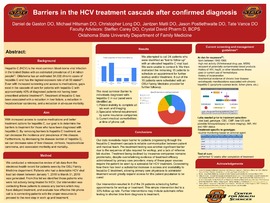| dc.contributor.author | de Gaston, Daniel | |
| dc.contributor.author | Hitsman, Michael | |
| dc.contributor.author | Long, Christopher | |
| dc.contributor.author | Matli, Jantzen | |
| dc.contributor.author | Postlethwaite, Jason | |
| dc.contributor.author | Vance, Tate | |
| dc.date.accessioned | 2020-04-14T16:12:31Z | |
| dc.date.available | 2020-04-14T16:12:31Z | |
| dc.date.issued | 2019-02-22 | |
| dc.identifier | ouhd_degaston_barriersinthe_2019 | |
| dc.identifier.citation | de Gaston, D., Hitsman, M., Long, C., Matli, J., Postlethwaite, J., & Vance, T. (2019, Feb. 22). Barriers in the HCV treatment cascade after confirmed diagnosis. Poster presented on Research Day at the Oklahoma State University Center for Health Sciences, Tulsa, OK. | |
| dc.identifier.uri | https://hdl.handle.net/11244/323836 | |
| dc.description.abstract | Background: Hepatitis C (HCV) is the most common blood-borne viral infection in the United States with an estimated prevalence of 2.4 million people[1]. Oklahoma has an estimated 54,000 chronic cases of hepatitis C and has the highest exposure rate of all 50 states[2]. Even with increased screening and access to medications, gaps exist in the cascade of care for patients with hepatitis C with approximately 40% of diagnosed patients not having been prescribed antiviral treatment[3]. Treatment of hepatitis C has been associated with a reduction in liver failure, a reduction in hepatocellular carcinoma, and a reduction in all-cause mortality. | |
| dc.description.abstract | Aim: With increased access to curative medications and better treatment options for hepatitis C, our goal is to determine the barriers to treatment for those who have been diagnosed with hepatitis C. By removing barriers to hepatitis C treatment, we can decrease the incidence and prevalence of this disease. Furthermore, by decreasing the disease burden of hepatitis C, we can decrease rates of liver disease, cirrhosis, hepatocellular carcinoma, and associated morbidity and mortality. | |
| dc.description.abstract | Method: We conducted a retrospective review of lab data from the electronic health record for patients seen by the OSU Family Medicine department. Patients who had a detectable HCV viral load lab drawn between January 1, 2018 to March 31, 2019 was generated. From this list we identified those patients who were not actively being treated for HCV. Our intervention was contacting these patients to assess any barriers which may have delayed treatment, and evaluate how effective this phone call is in connecting patients with the proper resources to proceed to the next step in work up and treatment. | |
| dc.format | application/pdf | |
| dc.language | en_US | |
| dc.publisher | Oklahoma State University Center for Health Sciences | |
| dc.rights | The author(s) retain the copyright or have the right to deposit the item giving the Oklahoma State University Library a limited, non-exclusive right to share this material in its institutional repository. Contact Digital Resources and Discovery Services at lib-dls@okstate.edu or 405-744-9161 for the permission policy on the use, reproduction or distribution of this material. | |
| dc.title | Barriers in the HCV treatment cascade after confirmed diagnosis | |
| osu.filename | ouhd_degaston_barriersinthe_2019.pdf | |
| dc.type.genre | Presentation | |
| dc.type.material | Text | |
